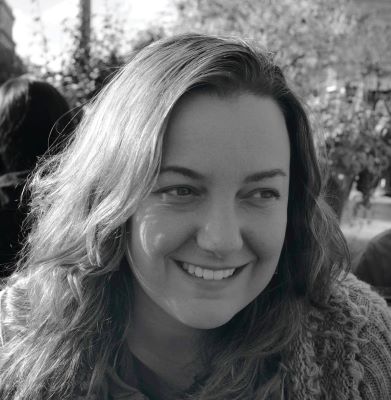Meet-the-Author Recording with Barbara DiLorenzo
One Thursday Afternoon |
Barbara DiLorenzo introduces and shares some of the backstory for creating One Thursday Afternoon.
Translate this transcript in the header View this transcript Dark mode on/off
Barbara DiLorenzo: Hi, my name is Barbara DiLorenzo and I am the author and illustrator of One Thursday Afternoon. When I first came up with the idea for this story, it wasn't because I was sketching ideas and thinking of some fun things to talk about in book form. It was actually, sadly, as a result of two life events where I was in a lockdown and I couldn't shake the feeling that somehow this needed to come into a book form to generate conversations with kids and caregivers about this aspect of our society that is there, but we don't always talk about it even among adults. I don't know how many conversations really occur with young people about this. So I thought the goal of a book about this topic would be to generate conversation between young people and their caregivers.
I didn't realize in the beginning how much of this was modeled on my own relationship with my father. He passed away two years ago, and I think he was just sort of on my brain. He was always incredibly patient talking to me and would treat me as a respected individual, not as an adult necessarily, but as a respected young person. We would have conversations about all kinds of things in life. There was space for my opinions, even if he had more facts, more life lived, and so that was really the model for this relationship although my dad never did paint. On one level, I'm very sad this book is out in the world and needs to be out there to help young students feel validated and heard, and maybe start conversations. I'm sad it's needed. I would much prefer to write a funny book and have that be out there.
My hope is that when students or any young people want to start a conversation and really connect with people they trust and share their feelings, whether it's lockdown drills or other anxieties, it really doesn't have to just live in that one sphere. I want them to feel like they can have a respected conversation with those people and sort out and untangle what they're going through. Not that anything is tied up in a bow, I purposely made the end of this book a little open ended because there isn't a clean answer right now to any of these issues. But I hope that the conversations lead in the right direction.
So here is an excerpt from the book that I find the heart of the story, it's not the end. It's when the grandfather and the granddaughter are talking in the shade. Here goes:
"When I was your age, we had safety drills called Duck and Cover. We had to hide under our desks," he said. "It was hard for us to understand. I never admitted it, but I was really scared back then. I still am sometimes." Ava took a deep breath. "Even you?" "Even me," said Granddad. "But Ava, even though the world is scary, it's also a beautiful place." "Sometimes." Ava said. "Let's paint now."
And they paint for a while and there's a wordless spread, and then she's sitting by herself. Ava felt a little better, but as Granddad went to his easel, she felt the sadness creep back. "Granddad, you may have been scared in school, but did you ever see news reports of schools in danger?" she asked. "I sometimes do." "I didn't, Ava," says Granddad, "You're right that the world can seem pretty different than when I grew up. But whether it's scary or beautiful or both, I'm here to listen."
This Meet-the-Author Recording with Barbara DiLorenzo was exclusively created in July 2022 by TeachingBooks with thanks to Flyaway Books.




